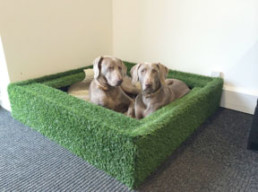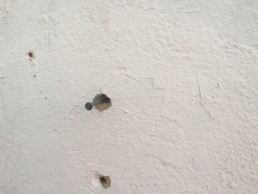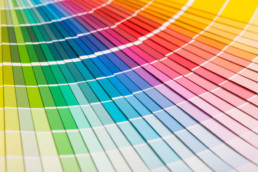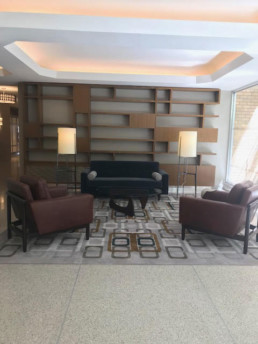Lobby Interior Design Ideas That Didn’t Fly
Interior designers get a lot of special requests lobbed at them from their clients, many of which they have to be gently talked out of. In my work as a specialist in lobby interior design, I probably get more crazy requests than the average interior designer. After all, I have an entire building full of condo/coop owners to deal with!
I must admit, sometimes building residents come up with great ideas; some of which I wouldn’t have thought of myself. But that’s not the norm. Over the years I’ve had to talk my clients out of some really crazy ideas that not only would bust their budget but in terms of practicality, just won’t fly.
I thought I’d share some of them with you:

Indoor Doggie Pit
Yes, you read it right. One of our clients had the wonderful idea of creating an indoor doggie pit in their lobby. This downtown building is full of creative, liberal, rule-breaking residents and they all seem to have dogs!
Of course, our dog-loving clients always get pee-pee resistant and nail-proof fabrics and rugs and easy to maintain floors. But these deep in dog culture condo owners wanted a place in the lobby where purse-dogs could “do their business” during inclement weather or late at night.
While a canine devotee myself, (my dog Hershey was so dear to me) I did not hesitate to explain to my clients how really impractical and a downright wrong decision an indoor doggie pit in the lobby would be. I explained it would be unsanitary, unsightly, and…not a good use of their budget.
Downcast faces aside, my clients didn’t put up too much of a fight.
Phew!

Lobby Color Scheme – Bright Red
During every lobby, interior design project their almost always is one resident who just has his or her mind set on a design element and it’s really hard to get that person to budge. Situations like this can hold a project up for months.
One such situation was a lobby re-do in a stunning mid-century modern condo building in the city. The resident of note was dead set in having us use bright red, not as an accent color, but as the dominant color of the entire area.
I love strong color, don’t get me wrong. Many hotel lobbies are done up in red with dramatic effect. But in an apartment building’s common area, where residents through every day? Not. A bright red lobby, red walls, red flooring, red furniture… just doesn’t fly.
Thankfully, it wasn’t too hard for me to convince the holdout resident in this case to change his mind. Thankfully, the other residents agreed with me. We used pops of red and everyone was very happy in the end.
Phew, again!

Revolving Artwork
We’ve worked on more than one lobby re-design project where the residents got stuck on the idea of having revolving artwork on the walls. Every month new pieces would be hung so there would always be something fresh to look at. And, in one or two instances, artists living in the building wanted a way to showcase their work.
Although changing the lobby artwork every month or so seems like an intriguing idea, in practice, it’s a nightmare.
Here’s why:
Art is a very significant element in all our lobby interior design ideas. In my experience, when art is integrated into the overall design, the more welcoming the room. Changing art all the time erodes the meticulously conceived look and feel that we aim to achieve.
But there’s an even more important reason that revolving lobby artwork doesn’t fly: it messes up the walls!
Each time the art changes, new holes are put into the walls. They get scratched and marked up. That’s not what anyone wants to see on a daily basis (unless you live in the Chelsea Hotel!).
Thankfully, I’ve been able to convince all my wishful revolving artwork clients to instead settle on distinctive pieces that are interesting, surprising, and look fantastic right where they are!
Read: How To Pick Art For A Room That Complements Your Interior Design
I’m an interior designer. But my job description also includes “the voice of reason”. Having designed more lobbies than I can count, I’ve developed an innate sense of what’s in the best interest of my clients. My goal is to make sure that the majority of residents are ecstatically happy with their new lobby and that it will serve as a wonderful welcome for many years to come.
Sygrove Interior Design Services
Sygrove Associates Design Group is an NYC interior design company. Our company’s founder Marilyn Sygrove is the lead interior designer on all projects. And she’s as tough as you are when it comes to quality, aesthetics, and coming in on time and on budget.
It all starts with a design consultation with Marilyn. She takes the time to thoroughly understand your design needs then personally directs all interior design, planning, and installation activities. Her work has been delighting clients, co-op and condo boards, and homeowners for over 30 years.
You can reach Marilyn by email at hello@sygrove.com or call her directly at 212.757.0631.
Share This Article
How Color Influences Mood in Interior Design

One of the most important roles of an interior designer is to be an expert on color. That’s because color influences mood more than most people realize. Each human motion can be impacted by color. If you’ve ever walked into a room and felt slightly unsettled, the colors used in that room could be one reason why.
You may have a favorite color but it may not be the best choice to use in your living room. That’s where I come in. In my work as an interior designer, it’s up to me to make the right color choices to achieve the feeling my clients want in each of their rooms. As much as you may love puce, it could end up being an unfortunate choice for your living room walls.
At Sygrove Associates we typically work with two types of clients:
1. Condo and coop buildings that hire us to design lobbies, entrance areas, and hallways.
2. Homeowners who hire us to design their entire house.
We’re very fortunate that we get a lot of both types of client! However, our most challenging work in terms of color is apartment building projects. Here’s why:
How Color Influences Mood in Interior Design – Apartment Buildings
Quite a few individuals are involved in the decision making when a coop or condo building gears up for a lobby and hallway re-design. First, there’s the board that is in charge of interviewing prospective interior designers, presenting a short list to the residents, and ultimately, hiring the firm.
The other voice in decisions about lobby interior design is the building management company whose main concerns in regard to color is care, maintenance, and longevity.
Then you have the residents themselves. During the design stage, it’s not uncommon for me to witness sometimes-heated discussions among residents around the topic of color.
So, when it comes down to creating color palettes for apartment building common spaces, it’s my job to make everyone happy. And that’s where there is no substitute for experience. I’ve probably designed more building lobbies and hallways than any other interior designer in New York City. So, I’ve learned a few things along the way.
One of my guiding principles is that floors and ceilings should be finished in neutrals because they will need not to be refreshed as often as will the furniture, rugs, and accessories, mostly because of wear and tear. It’s a whole lot easier to refresh a lobby with a new sofa than to repaint the ceiling and refinish the floors.
Neutrals, however, don’t have to be boring. Today we have an endless array of paint choices and finishes from a myriad of soothing soft greys to inviting warm taupes. Plus, a wide selection of application techniques that we can use to create texture and depth. New Yorkers live hectic lives and many of our clients really appreciate coming home to a calm and soothing lobby and a seamless transition on the way up to their apartments.
Color can be played with for the lobby furniture and accessories. Sometimes clients request very strong colors, but we’re careful to choose versions of those colors that are not jarring or produce anxiety. One of our recently completed lobby re-dos in Greenwich Village is a perfect example:
The residents of this iconic mid-century modern were determined to retain the building’s stylistic integrity in their new lobby design. However, the types of colors popular when the building was built such as deep teals, mustards, and burgundies (what we refer to as highly saturated) can evoke heaviness, which can make a room feel somber, even claustrophobic.
Our choice was to use versions of those mid-century colors but less saturated ones. So, we stayed true to the midcentury style, but the feeling is lighter, airier, and more inviting. As you can see from the photo below (taken with my iPhone), we used dusty burgundy and muted teal for the furniture then set it off with warm and lovely natural wood and a neutral palette for the floor and ceiling.

How Color Influences Mood in Interior Design – Private Homes
Our residential clients, on the other hand, have a lot more freedom in terms of color. They often know exactly how they want their rooms to feel even before we start design work.
For example, we recently completed a full house interior design project in the suburbs for a stylish young couple. This dynamic husband and wife team are very into entertaining, have a bunch of kids, and love, love, love color! They shared their vision with us of a lavish, elaborate living/dining room that would make them and their friends feel like royalty. In contrast, they wanted the kids’ wing of the house to feel playful and happy.
To create that pampered royalty atmosphere we used a luscious color palette of lapis lazuli, malachite, powder blue, and deep plum. The kids’ wing, on the other hand, simply bursts with happiness due to the raspberry, sea foam, purple, lavender, lime green and marine blue color palette we used. What fun! They love it!
In Conclusion
Color influences emotion in interior design and the designer must have a deep understanding of color and the experience to know where and how to use it.
– Marilyn
Sygrove Interior Design Services
Sygrove Associates Design Group is an NYC interior design company. Our company’s founder Marilyn Sygrove is the lead interior designer on all projects. And she’s as tough as you are when it comes to quality, aesthetics, and coming in on time and on budget.
It all starts with a design consultation with Marilyn. She takes the time to thoroughly understand your design needs then personally directs all interior design, planning, and installation activities. Her work has been delighting clients, co-op and condo boards, and homeowners for over 30 years.
You can reach Marilyn by email at hello@sygrove.com or call her directly at 212.757.0631.

